Taste & Aroma Strategic Research Institute Co., Ltd. (Headquarters: Chuo-ku, Tokyo; President: Michihiro Koyanagi; hereinafter referred to as ‘Taste & Aroma Strategic Research Institute’) conducted taste analysis on 18 bottled green tea drinks and investigated taste trends based on the data. The institute analyzes and quantifies taste, aroma, and texture, working to visualize deliciousness. They have independently constructed a database of over 120,000 taste profiles and are a food tech think tank company that supports the food industry based on this data.
Summary
〇Monetary PI value – The monetary PI value of “strong drinks” was increasing.
〇The taste of a “strong drinks” – strong astringency and body, and it was suggested that this type of taste has become popular in recent years.
〇There was a tendency for men to prefer “strong drinks”.
In addition to “staple products*1,” bottled green tea drinks are available in various other types, such as “strong drinks,” “specific health food,” and “functional display food.” Among these, there is a rising demand for “strong drinks” (Figure 1).
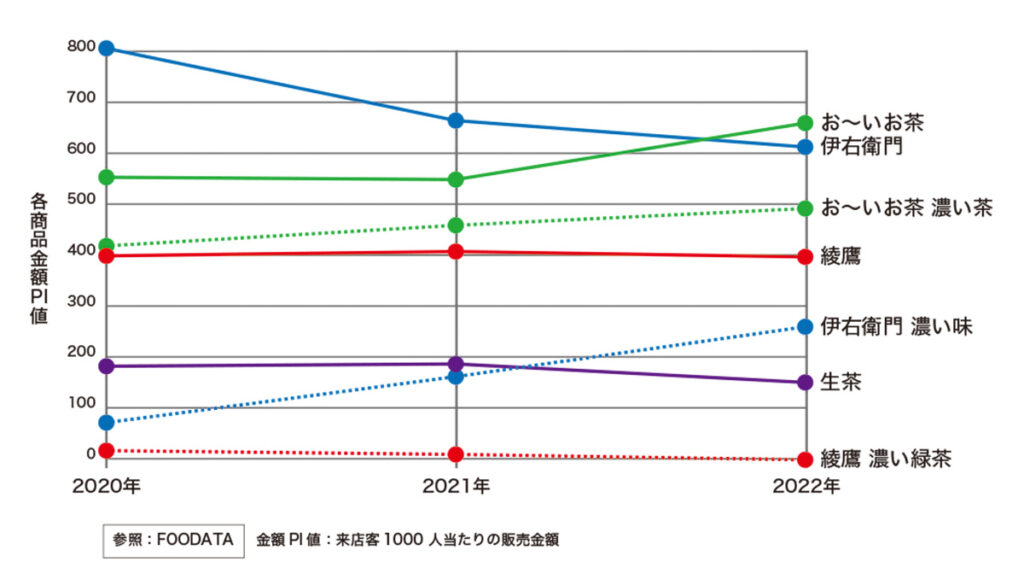
I wonder if there are trends even in the green tea drinks that are familiar to us at our dining tables. This time, we investigated the taste of currently available green tea drinks and the changes in taste in “staple products” and “strong drinks.”
Interpreting the Taste Trends of Green Tea Drinks from Flavor Data
Figure 2 shows the distribution of tastes of the 18 bottled green tea drinks*2. “Staple products” and “functional display foods” tend to be located near the center of the figure, while “strong drinks” have a strong, rich taste with pronounced bitterness and body.

As a “strong drink,” Nama-cha (raw green tea) was sold in limited quantities in 2006. Oi Ocha, Ito En, and Ayataka’s “strong drinks” have transitioned to “functional display foods” and their tastes are believed to have changed 1~3). Therefore, we derived the tastes of each year from the taste data of eight products from 2006, 2018 before they became “functional display foods,” and the current year of 2023, and compared the changes (Figure 3).
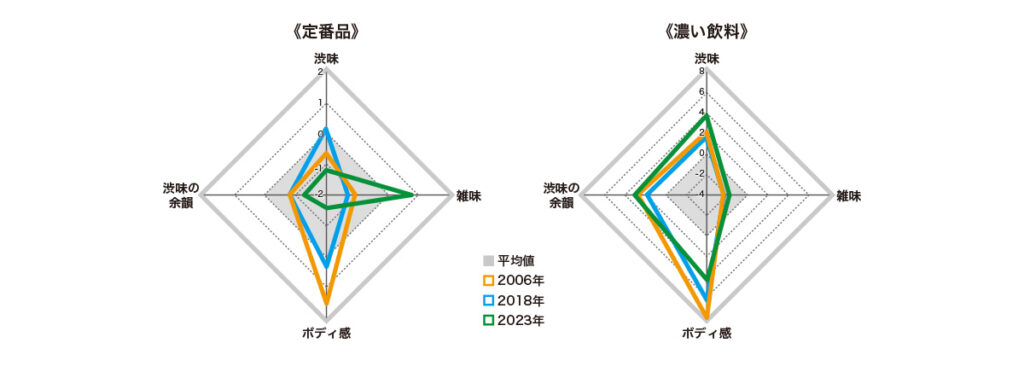
Excluding off-flavors, “strong drinks” generally had a stronger taste overall. In the “staple products” of 2023, bitterness, body, and the lingering bitterness were subdued. However, there was a trend of an increase in off-flavors. In the “strong drinks,” bitterness and the lingering bitterness became stronger in 2023. This is thought to be partly due to an increase in powdered green tea when transitioning to “functional display foods.”3)
The increase in the Price Index (PI) value for “strong drinks” (Figure 1) and the taste data suggest that there is a growing demand for strong flavors with strong body and bitterness.
Prediction of Consumer Segments Preferring Strong Bitterness
To consider the consumer segments that prefer strong bitterness, we compared the Price Index (PI) values and likability of “strong drinks” by gender and age group. Likability was determined using a proprietary likability diagnostic logic developed based on taste data from a database of over 120,000 food items, using a taste preference survey conducted by the Flavor & Fragrance Strategy Research Institute on over 7,500 people nationwide, which includes data on preferred tastes by gender, age group, and region.*4
The Price Index (PI) values for Oi Ocha Strong Tea and Ito En Strong Flavor were higher for men, excluding those in their 70s (Figure 4). Looking at the likability by age group for men (Figure 5), it can be seen that each age group, not just those in their 70s, showed different preferences. The increase in PI values for “strong drinks” (Figure 1) is thought to be influenced not only by taste but also by an increased awareness of health. In recent years, “strong drinks” have been marketed as “functional display foods” with the effect of reducing body fat. In the working-age group of 20 to 60 years old, it is thought that due to changes in lifestyle habits caused by the COVID-19 pandemic, such as lack of exercise, there has been an increase in demand for these products.
It was also considered that men had higher PI values for “strong drinks” than women because men showed a stronger preference for bitterness and strong flavors (Figure 6).
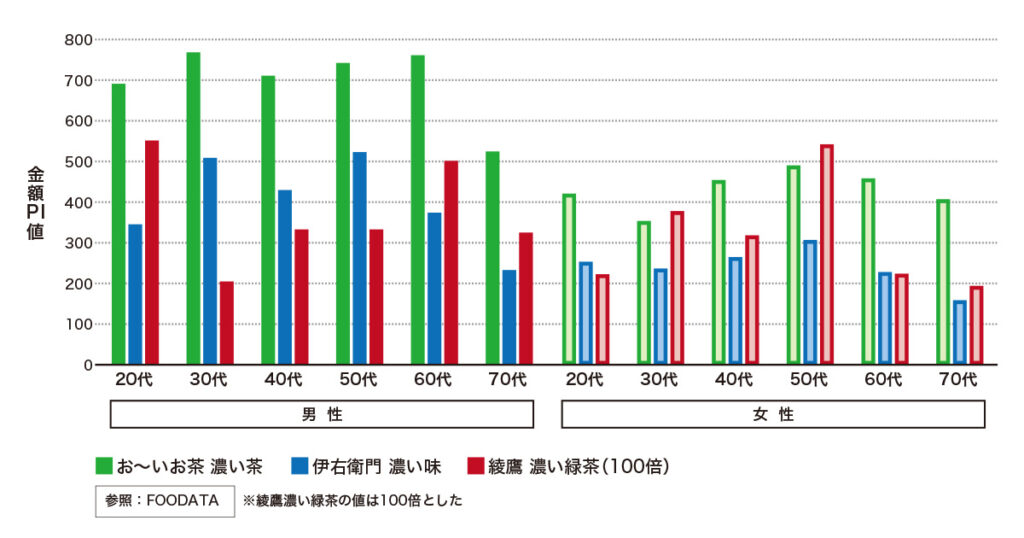
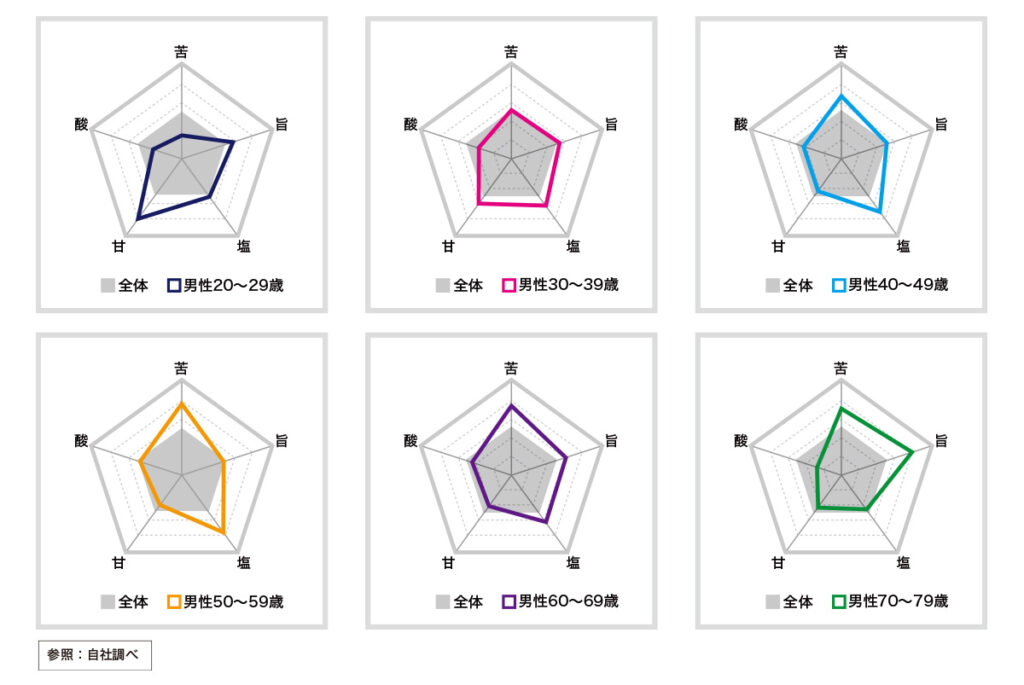
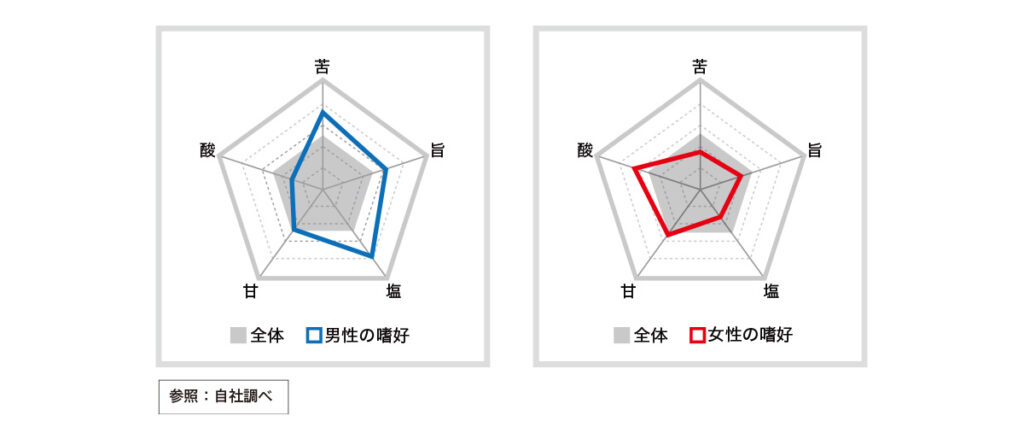
Summary
In this study, we quantified the taste of bottled green tea drinks and investigated the trends. Currently, the Price Index (PI) value for “strong drinks” is trending upwards (Figure 1), indicating that “strong drinks,” classified as functional display foods, are selling well due to changes in lifestyle habits caused by the COVID-19 pandemic. It was also considered that there is an increase in demand for products with strong flavors in general due to the changes during the pandemic, leading to an increased demand for products with strong bitterness in green tea (Figures 1-3). This suggests that while strong flavors are currently popular, preferred tastes may change depending on the era. Many new products of bottled green tea drinks are continually being developed, and we look forward to observing the trend changes in bottled green tea drinks in the future.
*1 Products other than strong drinks, foods for specified health uses, foods with functional claims, and decaf
*2 [Taste analysis summary] Green tea drinks in plastic bottles sold in 2023
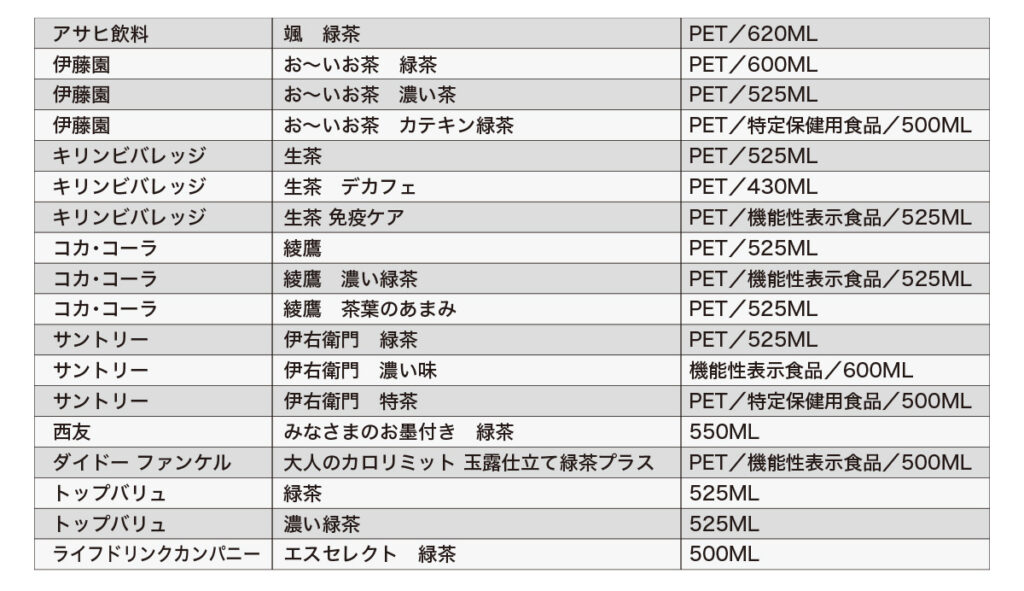
*3 [Summary of taste analysis] Year of measurement of major green tea drinks in PET bottles

1) ITO EN Co., Ltd., food with functional claims “Oi Ocha Koicha” will be on sale from August 5th (Monday), 2019.
2) Suntory, that “strong taste” is now a food with functional claims that reduces visceral fat with the power of tea catechins! , 2022.
3) Coca-Cola Japan Co., Ltd., “Ayataka Koi Green Tea” is now available as a food with functional claims, 2023.
4)Taste & Aroma Strategic Research Institute reveals regional “deliciousness” through palatability diagnosis program! ~Thorough examination of taste preferences by age and region~, 2023
About Taste and Aroma Strategy Research Institute
Taste & Aroma Strategic Research Institute, a company that studies the science of food, utilizes visualization technology for the “deliciousness” of taste, aroma, texture, etc. This technology allows for the objectification of sensory values that were previously perceived through relative evaluation, enabling them to be used as evaluation criteria and scales. Since its establishment, the institute has continued to digitize food, and has built a taste database of over 120,000 food items. Based on this database, they provide food digital solution services that utilize data for various challenges related to food, such as food development, quality management, market research, and customization of taste for overseas markets.
Contact information
Email sales@mikaku.jp
